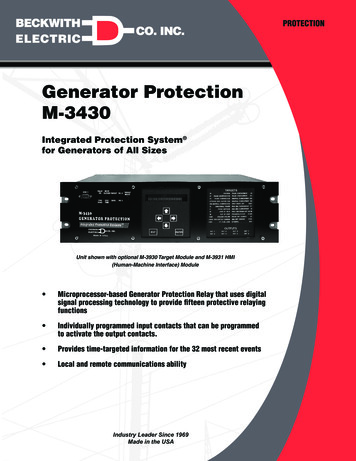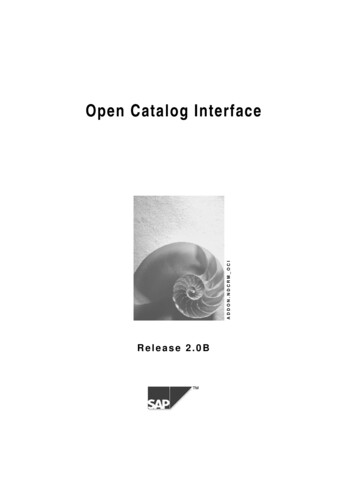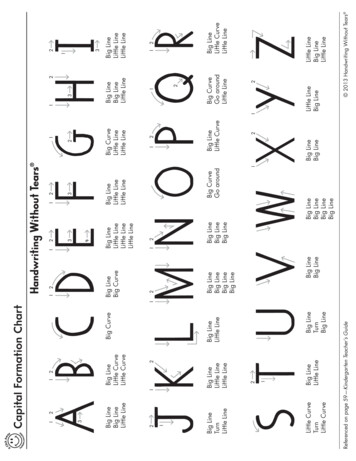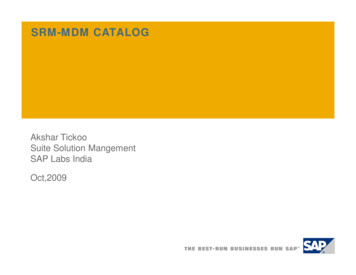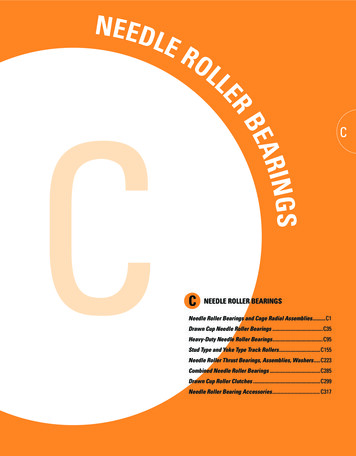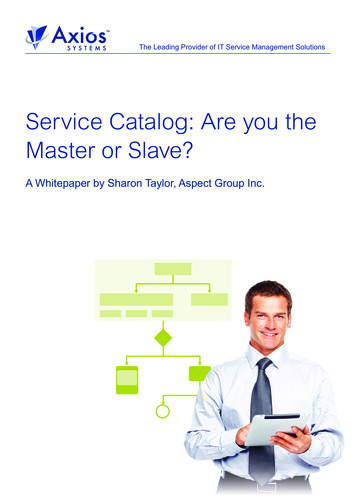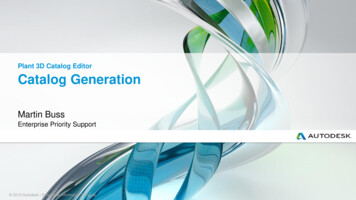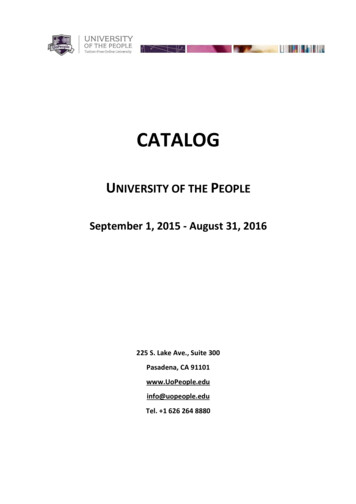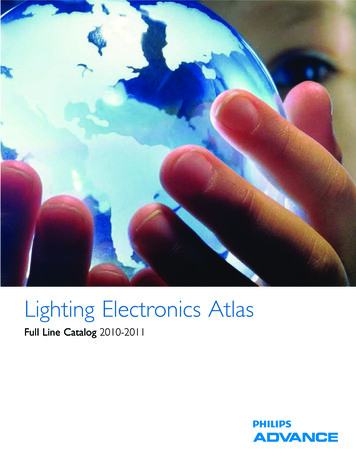
Transcription
Lighting Electronics AtlasFull Line Catalog 2010-2011
Lighting Electronics AtlasFull Line Catalog 2010-2011ContentsElectronic Fluorescent Ballasts1-1 to 1-69Electronic Fluorescent Controllable Ballasts2-1 to 2-25Electromagnetic Fluorescent Ballasts3-1 to 3-25Electronic HID Ballasts4-1 to 4-15High Intensity Discharge Ballasts5-1 to 5-57Specialty Products6-1 to 6-11Xitanium LED Electronic DriversControls7-1 to 7-58-1 to 8-21Additional InformationAdvance WarrantyIndustry TermsBallast SpecificationsFixed Light Output ElectronicControlled Light Output Electronic9-ii9-1 to 9-39-4 to 9-239-5 to 9-149-15 to 9-19Magnetic HIDElectronic HID [Metal Halide]9-209-21 to 9-22Xitanium LED DriversBallast Catalog Number to Page Number9-239-24 to 9-30Fluorescent9-24 to 9-28HID9-29 to 9-30eHID & IgnitorsDiscontinued Ballasts – Replacements9-309-31 to 9-39Electromagnetic Fluorescent9-31 to 9-32High Frequency Electronic Fluorescent9-33 to 9-34HID9-35 to 9-39Lamp Index9-40 to 9-44Fluorescent9-40 to 9-43HIDCompact Fluorescent Lamp Reference GuideVisit our on-line product catalog at www.philips.com/advance for the latest updates on all Philips Advance products.9-449-45
ElectronicFluorescent BallastsELECTRONIC FLUORESCENT BALLASTS1Centium Optanium AmbiStar StandardT5HOPureVOLT Lighting Electronics Atlas 2010-2011SmartMate
ELECTRONIC FLUORESCENT BALLASTSGeneral Information 1-2 to 1-21Compact Fluorescent Lamps 1-22 to 1-35CFL 1-22 to 1-28ElectronicFluorescent BallastsContentsPLH 1-29Long Twin Tubes 1-30 to 1-332D 1-34 to 1-35Linear Fluorescent Lamps 1-36 to 1-68T5 1-36 to 1-37T5 and T5HO Circline 1-38T5HO 1-39 to 1-40T8 1-41 to 1-62T8 Slimline 1-63T8HO 1-64 to 1-65T12 1-66T12 Slimline 1-67T12HO 1-68Note:Refer to page 9-5 to 9-14 for Ballast SpecificationsCorporate Offices(800) 322-2086Customer Support/Technical Service(800) 372-3331 ( ) 1 847 390-5000 (International)Visit our web site at www.philips.com/advanceLighting Electronics Atlas 2010-20111-1
ElectronicFluorescent BallastsELECTRONIC FLUORESCENT BALLASTSFluorescent Ballasts - Electronic - Standard ElectronicFor T12 Fluorescent LampsReliable and energy-efficient, Philips LightingElectronics broad line of standard electronic ballastsfor T12 fluorescent lamps offers performance andfast payback of investment based on the up to30% energy savings they drive relative to standardmagnetic ballast models. A widely popular productthat also qualifies for rebates by a host of utilitydemand-side management programs nationwide,the Philips Advance line of standard electronicballasts are ideal for a broad range of commercialretrofit and new construction applications.Improved efficiency over magnetic counterpartsPotential Savings of up to 30% over magnetic ballasts*Features2-lamp 34/40W versions are now available with IntelliVolt Stock 1 ballast for 4-foot, 2-lamp fixturesHigh frequency operationDelivers flicker-free operationFits the exact footprint of the magnetic ballasts they replaceEnhances ease of installation in retrofit applicationsThese ballasts are ideal for general office applicationsas well as conference, meeting, and board rooms.* Based on input watts of Philips Advance’s REL-1S40-SC (35W) and R-140-TP(50W) both operating a 40W lamp. (50W - 35W 15) (15 / 50 .3 or 30%)Benefits1-2Lighting Electronics Atlas 2010-2011
ELECTRONIC FLUORESCENT BALLASTSElectronicFluorescent BallastsFluorescent Ballasts - Electronic - Centium Electronics Ballasts for T5, T8, T12 and Long Twin Tube Fluorescent LampsReliable and energy-efficient, Philips Advance broadline of Centium high frequency electronic ballastsoffer all of the energy-saving properties of ourstandard electronic line plus the added benefitsof lamp striation reduction technology making theT8 ballasts compatible with all energy saving T8 lamps.This provides your customers with a more sustainablelighting solution over standard T8 fixtures.Setting Industry Standards for Ballast EfficiencyOur Centium ballasts are an optimal choice for abroad range of new construction and retrofitapplications within the commercial sector includinggeneral office lighting, conference, meeting, and boardroom applications, indirect and decorative lighting,and new fixture designs requiring smaller ballasts.Lamp Striation Reduction TechnologyReduces the likelihood of striation often associated withenergy-saving lamps, for consistent light outputThe National Electrical Manufacturers Association (NEMA)has created this program to help lighting professionalsand end users recognize the market’s highest-performingballast products. A selection of Centium ballasts meetthese requirements. For more information on whichproducts comply with this program, visit www.philips.com/advance and click on the “Sustainability” tab.IntelliVolt TechnologyEnhances accuracy and ease of ordering while reducingstocking requirementCold temperature lamp ignition down to -20 degrees FBrings energy-efficient T5 and T8 performance to a varietyof new applications such as parking garages, warehouses,and cold storage areasThe following ballasts are NEMA Premium CN4P32LWSCBenefitsAs a licensee in the NEMA Premium Ballast Program, Philips Lighting Electronics has determined that theseproducts meet the NEMA Premium specification for premium energy efficiency.Lighting Electronics Atlas 2010-20111-3
ElectronicFluorescent BallastsELECTRONIC FLUORESCENT BALLASTSFluorescent Ballasts - Electronic - Optanium High-efficiency electronic ballasts for a broad range of T5 and T8 lampsOptanium ballasts for T5 and T8 lamps are part ofour effort to promote environmental responsibilitythrough Smart Solutions - energy efficient products,lighting systems, services and expertise through PhilipsAdvance branded products. They are also one ofthe charter products of the NEMA Premium BallastProgram. All of this makes these ballasts part of anoverall high-efficiency lighting system that may helpyou achieve LEED certification, meet ASHRAEstandards, become compliant with California Title 24Energy Efficiency Standards, or any other local energycode you or your customers need to be in compliance.Optanium ballasts will help you and your customersmeet a variety of application challenges includingluminaire design, installation, maintenance, andevolving lamp technology. Optanium ballasts areavailable in a standard light output, low-watt, and ahigh light output design. Also these ballasts come inoptions with cold-starting capability down to -20 F(with standard fluorescent lamps). These two featurescombined make it ideal for just about any T5 orT8 fixture design and application. These ballasts areavailable in either instant start or programmed startignition for extended lamp life in frequent switchingapplications such as those where occupancy sensorsor motion detectors are being used. Optanium ballastsare also available in program start with parallel wiring.The following 32-LW-SCIOP-2P32-HL-SCIOP-3P32-SCIOP-3P32-LW-SCare NEMA Premium Lighting Electronics Atlas 2010-2011As a charter product in the NEMA Premium Ballast Program, Optanium ballasts are recognized assupporting energy-efficient lighting objectives. The NationalElectrical Manufacturers Association (NEMA) has createdthis program to help lighting professionals and end usersrecognize the market’s highest-performing ballastproducts. For more information on the NEMA PremiumBallast Program, visit www.philips.com/advance and clickon the “Sustainability” tab.Striation-reduction technologyReduces the likelihood of striation often associated withenergy-saving lamps, for consistent light outputCold temperature lamp ignition down to -20 F for instantor program start ballastsBrings energy-efficient T5 and T8 performance to a varietyof new applications such as parking garages, warehouses, andcold storage areasArc-reduction technology — UL Type CCUL Type CC* (on certain ballasts)Program start parallel (PSP)Program start ballasts with parallel wiring deliversindependent lamp operation preventing premature lampshut down ultimately reducing maintenanceHigh efficiency designMaximize energy savings with improved ballast P32-LW-SCIOPA-4P32-HLAs a licensee in the NEMA Premium Ballast Program, Philips Lighting Electronics has determined that theseproducts meet the NEMA Premium specification for premium energy efficiency.1-4Setting Industry Standards for Ballast Efficiency
ELECTRONIC FLUORESCENT BALLASTSElectronicFluorescent BallastsFluorescent Ballasts - Electronic - SmartMate Electronic Ballasts for 4-Pin Compact Fluorescent LampsOffering maximum versatility, the Philips Advancefamily of SmartMate electronic ballasts for 4-pincompact fluorescent lamps drive a broad range ofquad and triple-tube, circline, 2D, and long twin-tubelamps. Representing an innovative breakthrough inCFL ballast technology, SmartMate Ballasts’ energyefficient design, compact and lightweight housing, anduser-friendly features make SmartMate Ballasts an idealchoice for fixture manufacturers, retrofitters, and MROreplacement.Dual-entry connectorReduces SKU requirements and inventory costs, as unit canbe used with side or bottom exit leadsColor-coded, poke-in terminalsEnhances wiring accuracy and ease of assembly/installationOperation between 42kHz and 52kHzEliminates interference with infrared systems, anti-theftdevices, or other electronic equipmentLamp End-Of-Life (EOL) Protection CircuitRemoves power to lamps upon lamp failureSmartMate Ballasts are ideal in such applications asrestaurants, reception areas, conference and meetingrooms, hotel and convention center ballrooms, andhouses of worship, as well as in place of incandescentdown-lighting systems.We also offer our distribution partners a way toeliminate the need to stock loose components withSmartMate Ballast Replacement KitsConveniently-packaged these kits come completewith a Philips Advance SmartMate Ballast, a mountingplate adaptor, lead wire, and a wire extraction tool forthe ultimate in ease and versatility. See page 1-21 fordetails on kits.Lighting Electronics Atlas 2010-20111-5
ElectronicFluorescent BallastsELECTRONIC FLUORESCENT BALLASTSFluorescent Ballasts - Electronic - AmbiStar Residential Ballasts for 4-pin CFL, T5, T8 or T12 LampsToday’s fixed and dimmable fluorescent fixtures offergreater flexibility and energy savings for residential andhospitality settings than ever before, thanks to PhilipsAdvance AmbiStar electronic ballasts. No matterwhat type of fluorescent lighting you’re considering,these ballasts help create warm, inviting interiors whileproviding Class B FCC EMI Rating - a requirement forthe EPA ENERGY STAR residential lighting fixtures-at a very competitive price.Class B FCC EMI RatingRequirement for the EPA ENERGY STAR ResidentialLighting FixturesAmbiStar ballasts feature sleek, compact designsto fit in today’s stylish fixtures. AmbiStar ballastsdeliver quiet, flicker-free performance, whichmakes them perfect for any residential or hospitalitysetting. Fluorescent lighting isn’t just for garagesand basements anymore.Fast Start TimesFlicker free ignition starts in less than 1.0 second to meet EPAENERGY STAR Requirements for Residential Lighting FixturesAmbiStar dimming ballasts are designed to work withmost incandescent dimmers, so they are easy to installwith new or existing dimming systems. Now you cancreate any ambiance with dimmable lighting and stillenjoy the energysaving benefits of fluorescent lighting.NOTE: AmbiStar ballasts meet the ballast-controlled performance requirements in the ENERGY STARProgram Requirements for Residential Light Fixtures. The most current list of ballasts can be foundat www.philips.com/advance in the file “ENERGY STAR Ballast Matrix”.1-6Lighting Electronics Atlas 2010-2011Title 24 Energy Efficiency RequirementsEnables California’s Title 24 Residential Lighting EnergyEfficiency standards with applicable luminaire designElectronic circuitryEnable ballast to run cooler and operate quieter than manymagnetic ballast alternatives.
ELECTRONIC FLUORESCENT BALLASTSThe job of a ballastIn all fluorescent lighting systems, the ballast’s basic tasks include: Providing the proper voltage to establish an arcbetween the two electrodes. Regulating the electric current flowing through thelamp to stabilize light output.In some fluorescent lighting systems, the ballast also provides acontrolled amount of electrical energy to preheat or maintainthe temperature of the lamp electrodes at levels specified bythe manufacturer. This is required to prevent electrode filamentsdeteriorating prematurely and shortening the lamp life.Starting MethodsFor many years there were only three types of lighting systems:preheat, rapid start and slimline instant start. With the introductionof electronic ballasts, two additional types of lighting system circuitshave been added: instant start for T8 lamps and programmed start.Each requires a special ballast design to operate the lamps in thecircuit properly.Instant start electronic ballasts start lamps without delay ( 0.1seconds) or flicker by providing a starting voltage that is sufficientlyhigh to start a discharge through the lamps without the need forheating lamp electrodes. For F32T8 systems, the starting voltage isabout 600V. The elimination of electrode heating maximizes energysavings — typically saving 2W per lamp compared to rapid startballasts. Instant start ballasts are best suited for applications withlimited switches each day. Lamps operated by instant start ballaststypically operate 10,000 to 15,000 switch cycles before failure.Rapid start electronic ballasts start lamps quickly (0.5 — 1.0 seconds)without flicker by heating the lamp electrodes and simultaneouslyapplying a starting voltage. The starting voltage of about 500V forF32T8 systems is sufficient to start a discharge through the lampswhen the electrodes have reached an adequate temperature.Electrode heating continues during operation and typically consumes2W per lamp. Lamps operated by rapid start ballasts typicallyoperate 15,000 to 20,000 switch cycles before failure.Programmed start electronic ballasts also start lamps quickly(1.0 -1.5 seconds) without flicker. Programmed start ballastsare designed to maximize lamp life in frequent lamp startingapplications such as in areas where occupancy sensor controlsare used. Programmed start electronic ballasts precisely heat thelamp electrodes, tightly controlling the preheat duration beforeapplying the starting voltage. This enhancement over rapid startballasts minimizes electrode stress and depletion of emitter material,thereby maximizing lamp life. Lamps operated by programmed startballasts typically operate up to 50,000 switch cycles before failure.CircuitsSeries vs. Parallel. Lighting systems are typically wired in a series orparallel circuit. When a ballast is operating multiple lamps in a seriescircuit, if one lamp fails, the circuit is opened and all the lamps willextinguish. When a ballast operates multiple lamps in a parallelcircuit, the lamps operate independently of each other so, if onelamp fails, the others can keep operating as the circuit betweenthem and the ballast remains unbroken.As a general rule, rapid start ballasts are wired with the lamps inseries. Programmed start ballasts are also typically wired with lampsin series. However, some three- and four-lamp ballasts featureseries-parallel operation; so that when a single lamp in one branchfails, the lamp(s) in the parallel branch will continue to operate.Instant start ballasts are typically wired with the lamps in parallel.ElectronicFluorescent BallastsElectronic Ballast FundamentalsThe Language of BallastsInput Voltage (dedicated vs. multi). Most ballasts are designed tooperate at specific voltages. Newer electronic ballasts, including PhilipsAdvance models that use IntelliVolt technology, offer much greaterflexibility and other advantages such as inventory reduction. Today’sincreasing demands on electrical utilities can cause wide voltagevariations during load demand changes which in turn cause lightoutput from lamps operated on dedicated electronic andelectromagnetic ballasts to vary with the input voltage changes.With IntelliVolt technology, many Philips Advance ballasts maintainconstant light output through nominal input voltage ranges of 120to 277 volts, thereby compensating for any change in input voltage.Some ballasts operate from 277 to 480 volts or 347 to 480 volts.Input Watts/ANSI Watts. Input watts published by ballastmanufacturers are the total watts consumed by both the ballastand the lamps it operates. ANSI watts are the rating given for aballast measured under the strict testing procedures specified byANSI standards and are a dependable measure of this lamp/ballastperformance. Energy savings can be determined by comparing theinput watts of different lighting systems.Input watts may be affected by tolerance build-up from the ballast,lamp, input voltage and ambient temperature. The input wattspublished in this catalog are for nominal conditions only.Ballast Factor (BF) is the ratio of light output from a lamp operatedon a commercial ballast to the light output of that same lampoperated on a “reference ballast” as specified by ANSI standards.Light output ratings published by lamp manufacturers, are based onthis “reference ballast”.BF light output of lamp operated on commercial ballastlight output of lamp operated on reference ballastBF is a measure of light output best thought of as a ‘multiplier’.Multiplying the BF times rated lumens will determine actual lightoutput of a given system operated on commercial ballasts.Ballast Efficacy Factor (BEF) is the ratio of ballast factor to inputwatts. This measurement is generally used to compare the efficiencyof various lighting systems — higher numbers being more efficient.Ballast Efficacy Factor Ballast Factor x 100Input WattsThis comparison is only valid, however, for ballasts operating thesame number and type of lamps. In order to compare differenttypes of lighting systems, the lumen output of the lamps must alsobe used.Lighting Electronics Atlas 2010-20111-7
ElectronicFluorescent BallastsELECTRONIC FLUORESCENT BALLASTSPower Factor (PF) is the measurement of how effectively aballast converts the voltage and current supplied by the power sourceinto watts of usable power delivered to the ballast and lamps. Perfectpower utilization would result in a power factor of one.Input WattsPF Input Current x Input VoltageA ballast’s power factor may be classified under any one of thefollowing categories:High Power Factor (HPF)0.90 or greaterPower Factor Corrected (PFC)0.80 to 0.89Normal (Low) Power Factor (NPF)0.79 or lessPower factor measurements pertain only to the effective use ofpower supplied to the ballast. They are not an indication of theballast’s ability to supply light through the lamps. Because low powerfactor ballasts require about twice the current needed by high powerfactor ballasts, they allow fewer fixtures per circuit and create addedwiring costs. High power factor ballasts are generally specified for allcommercial lighting applications.EMI/RFI. Because they operate at high frequency, electronic ballastsmay produce electromagnetic interference (EMI) or radio frequencyinterference (RFI). RFI frequencies are a subset of EMI frequencies.EMI issues cover all possible operating frequencies while RFI is onlyconcerned with radio and television frequencies. This interferencecould affect the operation of sensitive electrical equipment, suchas radios, televisions or medical equipment. All Philips Advanceelectronic ballasts incorporate features necessary to afford maximumprotection for the operating environment and operate well withinregulatory limits.Ballast Noise. The slight “humming” sound associated withfluorescent lighting systems results from vibration caused by theinherent electromagnetic action in the core-and-coil assembly of theballasts. All electromagnetic and some electronic ballasts make thissound. Ballasts are assigned a sound rating, “A” through “F”, basedon the amount of sound produced, with “A” being thequietest. Generally, the larger the lamp and ballast, the higher thesound level and the sound rating will be. Because electronicballasts have smaller components, they have the lowest soundrating. Some electronic ballasts make almost no sound. There is noANSI standard for this rating and it is left up to the manufacturer torate their ballasts.Inrush Current. All electrical devices including ballasts havean initial current surge that is greater than their steady-stateoperating current. A standard published by the National ElectricalManufacturers Association (NEMA) — NEMA 410 — PerformanceTesting for Lighting Controls and Switching Devices with ElectronicFluorescent Ballasts — covers worst-case ballast inrush currents. Allcircuit breakers and light switches are designed for inrush currents.The electrical system should be designed with this issue in mind.1-8Lighting Electronics Atlas 2010-2011Total Harmonic Distortion (THD). Harmonic distortion occurs whenthe wave-shape of current or voltage varies from a pure sine wave.Except for a simple resistor, all electronic devices, including electromagnetic and electronic ballasts, contribute to power-line distortion.For ballasts, THD is generally considered the percent of harmoniccurrent the ballast adds to the power distribution system. The ANSIstandard for electronic ballasts specifies a maximum THD of 32% forcommercial applications. However, most electric utilities now requirethat the THD of electronic ballasts be 20% or less. Almost all PhilipsAdvance electronic ballasts are rated for either less than 20% THD orless than 10% THD.Phase AActual WaveformThird Harmonic(180Hz)Phase BLow CurrentNeutral WireIf low Third Harmonicon balanced systemPhase CPhase A60 Hz SineWavePhase B100% Plus CurrentNeutral Wire(Overheated)ThirdHarmonicPhase CIndicates ballast is listed with Underwriters Laboratories,Inc. and complies with UL935 Standard for FluorescentLamp Ballasts (File No. E14927).Visit www.ul.com to find a current listing of Philips Advanceballasts under File No. E14927.Indicates ballast is certified by Canadian StandardsAssociation and complies with CSA C22.2 No. 74Standard for Fluorescent Lamp Ballasts (File No.007310)Visit www.csa.ca to find current listing of Philips Advance ballastsunder File No. 007310.Normal InputVoltageCatalog NumberPrefix CodeLabel ColorCoding120VRYellow277VVRed347VGGrey120V to 277VIBlue277V to 480VJBrown347V to 480VHPurple
ELECTRONIC FLUORESCENT BALLASTSNon-Dimming ApplicationsWhen selecting a ballast for a lighting application, the TotalHarmonic Current (THC) rating of the ballast is more significantthan Total Harmonic Distortion (THD). This is because theabsolute value of harmonic current, not the percentage, affectsthe electrical power distribution system. As can been seen in thetable below, the THC rating of our Standard 2-lamp electronicT8 lamp ballast (REL-2P32-SC) is well below that of both theconventional (RQM-2S40-TP) and energy-saving magnetic T12lamp ballasts (R-2S40-TP) it replaces. Moreover, the THC ratingof our Centium electronic ballast is even lower.Dimming ApplicationsMark 7 0-10V and ROVRTMTraditional low voltage controlled ballasts and ROVR typicallyproduce less than 10% THD at full light output and less than20% THD throughout the entire dimming range, but require extrawires for the control circuit. THC is always lower than that of theconventional or energy-saving magnetic system.Mark 10 PowerlineMark 10 Powerline electronic dimming ballasts are controlledby 2-wire modified powerline phase-cut style line voltagedimmers. Whenever the ballast is dimmed, the input voltageis cut or “chopped”, causing the THD to increase and the PowerFactor to decrease.lighting systems they replace. Since a much smaller load is requiredby the Mark 10 Powerline electronic dimming system to achieve thesame illumination level as a magnetic ballast system (20-30% less), thetotal input current will be considerably less. As a result, the magnitudeof the total harmonic current will be less.ElectronicFluorescent BallastsTotal Harmonic CurrentFor example, a typical Mark 10 Powerline electronic ballast anddimmer control might draw a line current of 0.58A at 15% THD atfull light output. If the light level is reduced to 5% of the maximum,the input power is decreased to 0.19A at 95% THD. While theTHD level may seem high at the 5% maximum light outputsetting, the total harmonic current is still lower (0.13A) thanthe conventional T12 magnetic system (0.20A). Moreover,the overall heating effect on the wires and the distributiontransformer is never higher than the existing conventional orenergy saving T12 magnetic systems.1ConclusionsA simple ballast retrofit to electronic ballasts should not causeharmonic problems if none existed before the retrofit. Also, innew fixture applications, total harmonic distortion should not be aconcern when specifying electronic ballasts. Finally, it is importantto remember that electronic ballasts are not the greatest source ofTHD in an electrical distribution system. Other electronic devicessuch as computers, laser printers, and other electronic equipmentcan draw current with more than 100% THD in some cases.Mark 10 Powerline electronic dimming systems (ballast and controller)have similar THD and Power Factor levels as the conventionalTable 1: Comparison of THD and THC LevelsPhilips AdvancePart No.Light OutputSettingLampTypeInputCurrent% THDTHC2RQM-2S40-TPConventionalMagnetic100% (BallastFactor is 0.98)(2) F40T120.84A 25%0.20AR2S40-TPEnergy SavingMagnetic100% (BallastFactor is 0.95)(2) F34T120.63A 20%0.12AStandard100% (BallastFactor is 0.88)(2) F32T80.49A 20%0.10ACentium100% (BallastFactor is 0.88)(2) F32T80.49A 10%0.05AIZT-2S32-SC Dimming ControlMark 7 0-10V100% (BallastFactor is 1.0)(2) F32T80.57A 10%0.05AIZT-2S32-SC Dimming ControlMark 7 0-10V5% (BallastFactor is 0.05)(2) F32T80.12A 20%0.02AREZ-2S32-SC(Ballast Only)Mark 10 Powerline100% (BallastFactor is 1.0)(2) F32T80.58A 10%0.06AREZ-2S32-SC Dimming ControlMark 10 Powerline100% (BallastFactor is 1.0)(2) F32T80.58A 15%0.09AREZ-2S32-SC Dimming ControlMark 10 Powerline5% (BallastFactor is 0.05)(2) F32T80.19A cElectronicElectronicElectronicElectronicBallast DimmerBallast DimmerFor a more technical study comparing the a Mark 10 Powerline electronic dimming systemto an energy saving magnetic system that it replaces, see the article THD in Philips Advance Mark10 Powerline Electronic Dimming Systems by O.C. Morse.2The Total Harmonic Current (THC) of a ballast is calculated by the following equation:An approximation of THC may be obtained by simply multiplying the ballast input current by %THD.Ballast Input CurrentSquare Root of (1 1/THD2)Lighting Electronics Atlas 2010-20111-9
ElectronicFluorescent BallastsELECTRONIC FLUORESCENT BALLASTSBallast LifePhilips Advance fluorescent electronic and magnetic ballasts aredesigned and manufactured to engineering standards correlating toan average life expectancy of 50,000 hours of operation at maximumrated case temperature. Since Philips Advance ballasts operate belowtheir maximum case temperature in the majority of applications,increased ballast life can be expected. As a rule of thumb, ballastlife may be doubled for every 10 C reduction in ballast caseoperating temperature. However, there are many variables,such as input voltage, ambient temperature, etc. which affectballast operating temperatures, and therefore ballast life.Lamp Operating FrequencyElectromagnetic ballasts and the lamps connected to them operateat an input voltage frequency of 60 Hertz (Hz), 60 cycles persecond — which is the standard alternating voltage/current frequencyprovided in North America. Electronic ballasts, on the other hand,convert this 60 Hz input to operate lamps at much higherfrequencies above 20 Kilohertz (kHz), 20,000 cycles per second.Philips Advance ballasts operate above 20 kHz, but avoid certainranges such as 30-40 kHz (infrared) and 54-62 kHz (theft deterrentsystems) due to interference issues.Because electronic ballasts function at high frequency, the fluorescentlighting systems that they operate can convert power to light moreefficiently than systems operated by electromagnetic ballasts (Seechart below). For example, lamps operated on electronic ballastscan produce over 10 percent more light then if operated on electromagnetic ballasts at the same power levels. In effect, today’s electronicballasts provide additional energy savings by matching the light outputfrom electromagnetic ballasts while operating the lamps at lowerpower. This is the main reason why electronic ballast systems aremore efficient than magnetic ballast system.electromagnetic models. Almost all Philips Advance electronicballasts have a smaller cross-section than electromagnetic ballastsbut maintain the same mounting dimensions. This means that theycan fit into all new fixture designs and can be easily retrofitted intoexisting fluorescent lighti
Reliable and energy-efficient, Philips Advance broad line of Centium high frequency electronic ballasts offer all of the energy-saving properties of our standard electronic line plus the added benefits of lamp striation reduction technology making th

